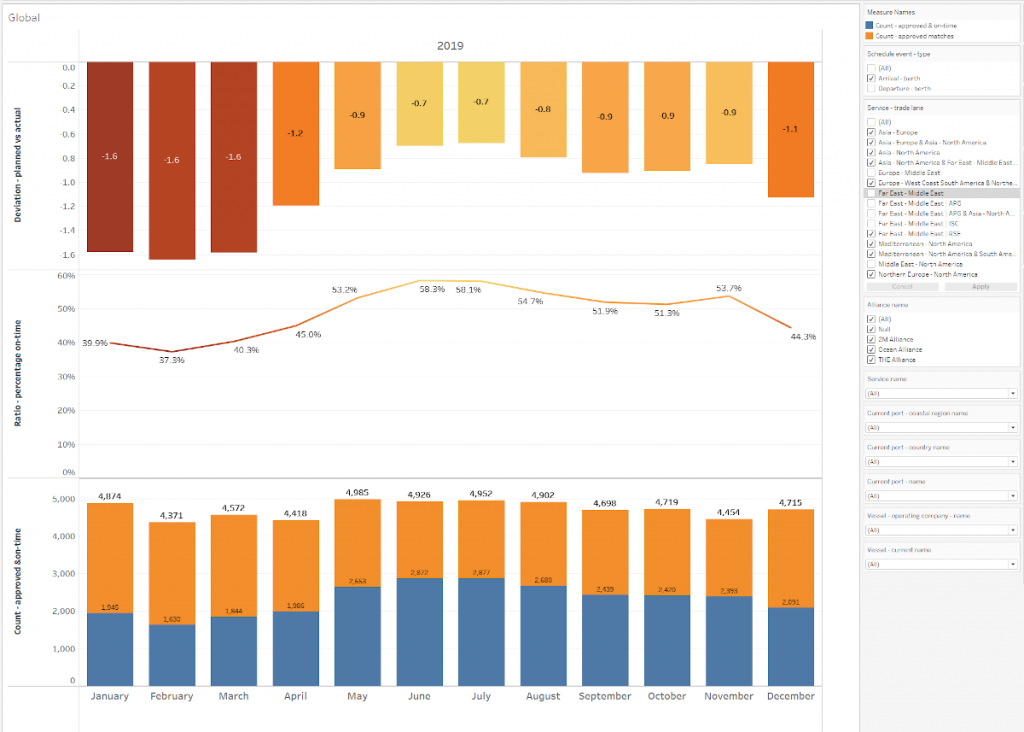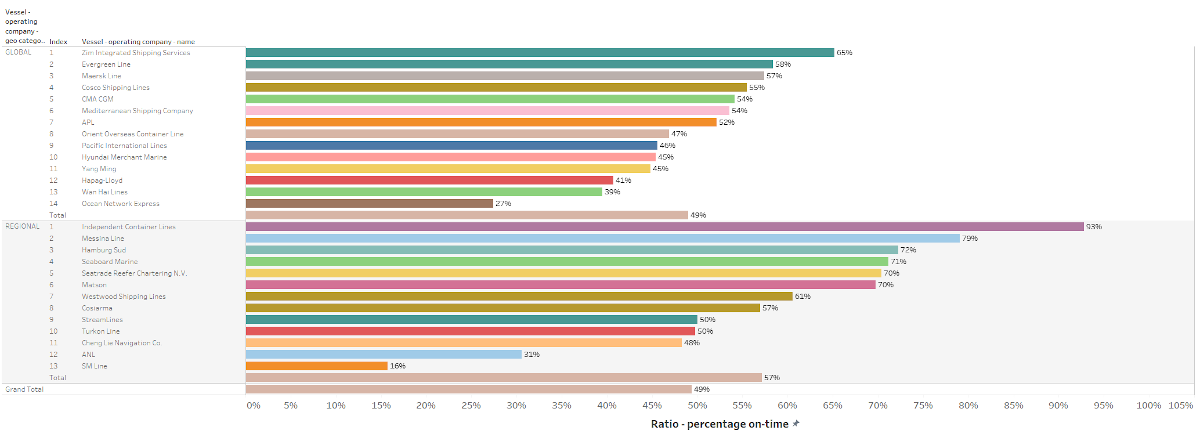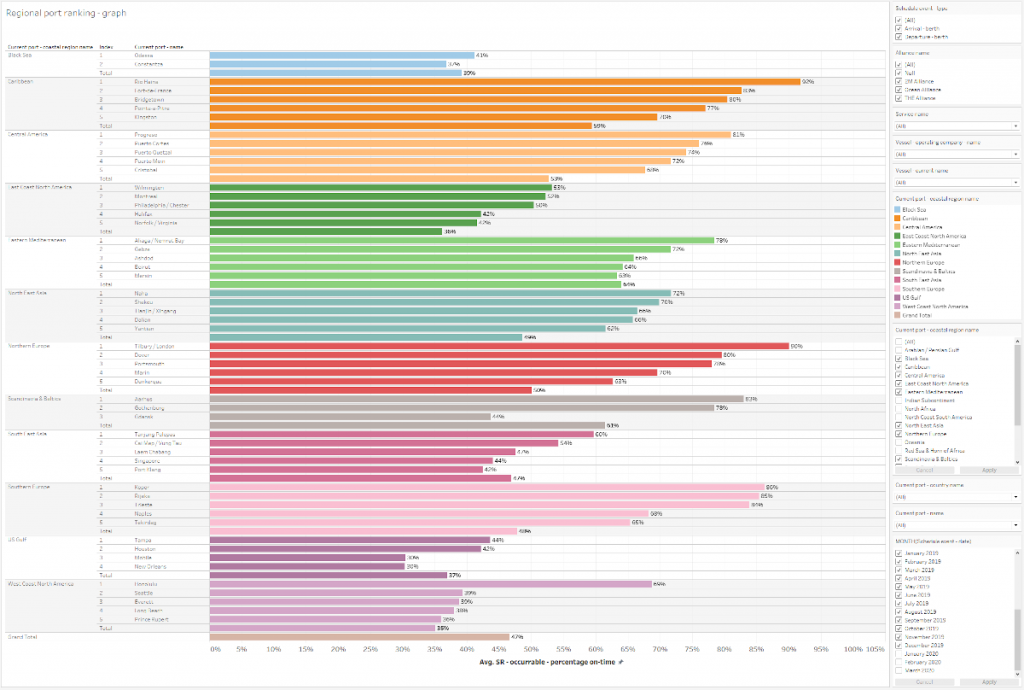eeSea unveils 2019 Liner Schedule Reliability rankings
Jan 17, 2020- On-time reliability on East/West trades concluded 2019 at 47%. 10% of all arrivals were more than 3 days delayed
- Zim Integrated tops table for 2019 global liner reliability. Port of Rio Haina most reliable port
- eeSea publishes the definitive global liner reliability rankings
Copenhagen - Zim Integrated has emerged as the top performing carrier in the 2019 container shipping Schedule Reliability Report published by eeSea, with the Dominican Republic’s Port of Rio Haina topping the rankings for port reliability performance.
Overall, global liner schedule on-time performance ended the year at 43% reliability in December, down from the full year average of 47%. This corresponded to 1.6 days delay on average across 2019.
In the world of container alliances, 2M topped the table at 56% of services on time across 2019, but dropped to 44% in December, below Ocean Alliance.
The eeSea 2019 Schedule Reliability Report is the most comprehensive and accurate report published into global container shipping reliability. It is based on over 400,000 data points, currently reporting on the three major East/West trade routes and all underlying container lines and ports.
The report has been developed by Copenhagen-based eeSea, a maritime and supply chain intelligence company, focused on visibility and predictive analysis for the global container shipping industry.

2019 Liner Rankings
The report finds that Zim Integrated was the best performing global carrier in 2019, with 65% of all their vessels arriving on time, followed by Evergreen at 58% and Maersk Line at 57%. Meanwhile, Hapag-Lloyd, Wan Hai and ONE occupied the last three spots, with ONE posting an on-time percentage of just 27%.
Of the regional carriers, Independent Container Lines, with their TA1 service, posted an impressive 93% on-time percentage over 2019.
A vessel is deemed to be ‘on-time’ if a vessel reaches port within 8 hours of their standard proforma arrival.
The results are based on a total of 140,000 matched port arrival and departure events in 2019, across more than 130 services on the three main East-West liner trades. Some 12,000 events are being added each month, and trade scope will increase in 2020 to incorporate Middle East, Oceania and South America trades.

2019 Port Rankings
eeSea has also examined the reliability performance of over 150 global liner ports. Most impressive was the Dominican Republic’s Port of Rio Haina, with 92% of all arrivals and departures at their scheduled time. The United Kingdom’s Tilbury Port and Slovenia’s Port of Koper topped the rankings for their respective regions, at 90% and 86% of services departing on time respectively.
Meanwhile, 2019 was a bad year for North American liner shipping, with both the East and West Coasts nearly level as the lowest performing regions, at 36% and 35% reliability.

Simon Sundboell, founder and CEO of eeSea, commented: “We’re pleased to publish our report of 2019 Schedule Reliability for liner shipping, which provides a revealing insight into the container lines and ports that power the engine of global trade.
“By analysing thousands of port calls we are able to shed light onto truly global megatrends, providing actionable insight for carriers, cargo owners and ports alike. Through comparing proforma arrival and departure times with actual port events, we are able to provide a clear picture of the best performers across 2019.”
As Simon Sundboell explains, the eeSea Liner Schedule Reliability Report is supported by the eeSea data platform which provides users with the datasets that sit behind their ranking, enabling them to more accurately assess and improve their performance.
“The eeSea Reliability Report is just the start of the story. The rich data upon which the rankings have been built can be best understood through our platform. At a time when end-to-end visibility is more important than ever, the eeSea platform provides decision makers and analysts alike with actionable intelligence that will enable them to more accurately diagnose where reliability can be improved.
“No other platform offers such depth and precision of underlying data when it comes to mapping service performance and vessel movements, or the same level of accuracy in forecasting arrivals. This data can have a critical role for vessel operators, cargo owners and port communities when it comes to managing their assets and supply chains, avoiding costly incidents and reducing buffers and transit times.”
The eeSea platform can also be used to benefit and smooth business between the parties, Sundboell explains:
“One of the key benefits of deep, precise and accessible data is that it can be used as an impartial benchmark that informs contractual decision making within our sector. Terminals’ contracts with carriers and carriers’ agreements with cargo owners should be data driven, underpinned by a wealth of rich information about routes, port pairs and service patterns. This will be to the benefit of all parties, giving them clear performance indicators from data that can be interpreted by their own teams.”
Beyond the Schedule Reliability reporting, eeSea offers the related eeSea Vessel Forecasts platform. It is based upon a proprietary algorithm that combines multiple data sources, historical data, and elements of machine learning and AI, to provide constantly updated ETAs for given ports, vessels and liner services.
The platform offers real-time vessel tracking and forecasting up to 60 days into the future, allowing users to proactively plan and engage partners. Both Vessel Forecasts and Schedule Reliability can be set to analyse port-to-port combinations, benchmarking carriers and comparing planned to actual transit times.
Learn more about the eeSea data platform and Schedule Reliability Report
Similar Stories

Hapag-Lloyd orders 24 new container ships
View Article
Strategic Marine secures repeat order with OEG renewables for state-of-the-art crew transfer vessel
View Article
WiseStella eases SIRE2 challenge for shipmanagers
View ArticleFreightos Weekly Update
Trump’s victory in the US presidential election yesterday may start impacting the ocean freight market even before his January inauguration.
View Article
Carrier Transicold and Net Feasa introduce IoTPASS dry box telematics solution available through BlueEdge partner channel
View ArticleHapag-Lloyd partners with HERE Technologies to transform global supply chain visibility with advanced tracking solution
• Hapag-Lloyd has equipped over 1.5 million containers with advanced tracking devices, integrating HERE Tracking into their real-time tracking solution to enhance inland Estimated Time of Arrival (ETA) calculations across…
View ArticleGet the most up-to-date trending news!
SubscribeIndustry updates and weekly newsletter direct to your inbox!





